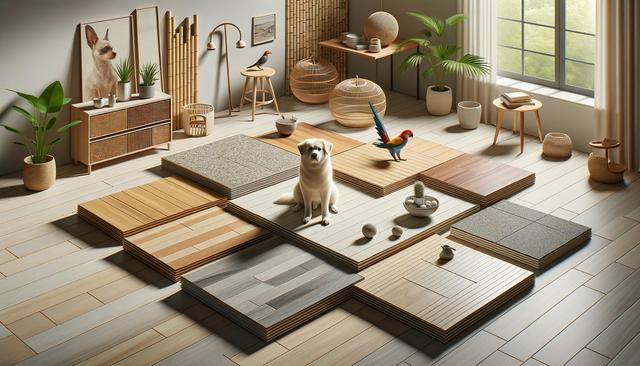Choosing the Right Pet-Friendly Flooring for Your Home
Finding the right flooring that accommodates both your lifestyle and your pets can make a big difference in comfort and durability.

Why Pet-Friendly Flooring Matters
When you have pets, flooring takes on a whole new level of importance. Whether it’s muddy paw prints, shedding fur, or the occasional accident, your floors endure quite a bit. Selecting pet-friendly flooring isn’t just about aesthetics—it’s about choosing materials that can handle wear and tear while being safe and comfortable for your furry companions. Some materials are more resistant to scratches, moisture, and stains, which can significantly increase the longevity of the floor. Additionally, pet-friendly options can reduce allergens and make cleaning up after your pets much easier.
Another important factor is your pet’s comfort. Hard, cold surfaces might be durable, but they can be uncomfortable for pets to lie on, especially older animals with joint issues. The right flooring can help your pets move around safely without slipping, which is especially important for dogs prone to hip or leg problems. By investing in the appropriate flooring, you’re not just protecting your home—you’re improving your pet’s quality of life.
Top Flooring Materials to Consider
Several flooring materials are known for their pet-friendly qualities. Each comes with its own set of advantages and considerations, depending on your specific needs and the type of pets you have. Here are a few popular options:
- Luxury Vinyl Plank (LVP): Known for its durability, water resistance, and comfort underfoot. It’s also relatively quiet and warm, which pets tend to appreciate.
- Tile: Highly durable and scratch-resistant, tile is excellent for homes with pets. However, it can be cold and hard, so consider using rugs or mats where pets rest.
- Laminates: Offers scratch resistance and a variety of styles. Choose high-quality laminates with water-resistant cores for better durability.
- Engineered Hardwood: A more pet-friendly alternative to traditional hardwood. Choose options with a strong protective finish to guard against scratches and spills.
When selecting a material, look for features like a strong wear layer, water resistance, and ease of cleaning. These factors will make a big difference in everyday maintenance and long-term appearance.
What to Avoid in Pet-Friendly Flooring
Just as there are ideal flooring types for pet owners, there are also materials that are less suitable. Being aware of these can save you from future frustration and costly replacements. Here are some materials you might want to avoid:
- Carpet: While comfortable, carpet tends to hold onto pet hair, dander, and odors. It also stains easily and can be difficult to clean thoroughly.
- Softwood floors: Woods like pine or fir are more prone to dents and scratches, making them a poor choice for homes with active pets.
- Unsealed hardwood: Without a protective finish, hardwood can quickly show signs of wear from pet claws and is vulnerable to moisture damage.
Floors with high polish or glossy finishes can also become slippery for pets, increasing the risk of injury. When choosing flooring, aim for a balance between aesthetics and practicality. A slightly textured surface can provide better traction for pets while still maintaining a clean look.
Additional Features to Look For
Beyond the material itself, several features can enhance the pet-friendliness of your flooring. These aspects can make a notable difference in how well your floors hold up and how comfortable they are for your pets. Features to consider include:
- Scratch resistance: Look for materials with a tough wear layer or coating to minimize visible damage from claws.
- Waterproof or water-resistant finishes: Accidents happen, and spills are inevitable. Water-resistant flooring helps prevent long-term damage.
- Noise reduction: Some materials, like cork or vinyl, naturally absorb sound, which can make a big difference if you have active pets running around.
- Ease of maintenance: Flooring that’s easy to sweep or mop can save time and effort in daily upkeep.
These features are particularly helpful in high-traffic areas like living rooms, kitchens, and entryways. By selecting flooring with these characteristics, you create a more functional and harmonious home for everyone.
Maintaining Floors with Pets
Even the most durable flooring benefits from regular maintenance, especially in homes with pets. Keeping your floors clean and protected can extend their lifespan and keep them looking their best. Here are a few maintenance tips:
- Use mats at entrances to catch dirt and debris from paws before it reaches your floors.
- Trim your pet’s nails regularly to reduce scratches.
- Clean up accidents promptly to prevent staining or moisture damage.
- Vacuum frequently to remove hair and dander, especially around baseboards and corners.
- Use pet-safe cleaners that won’t damage flooring finishes or harm your animals.
Additionally, consider placing rugs or runners in areas where your pets spend a lot of time. These not only protect the floor but also provide a soft, cozy area for your pet to relax. With the right habits, your floors can remain in great shape even in a lively, pet-filled home.